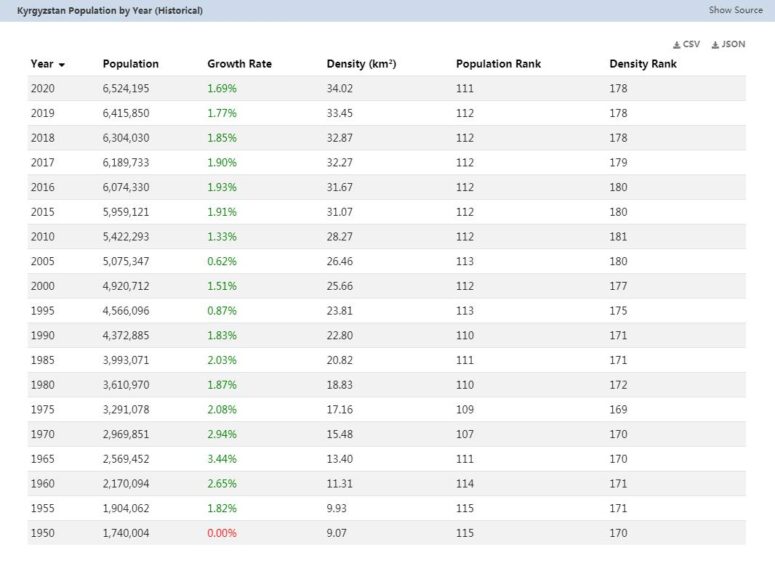Kyrgyzstan is located in Central Asia. The country borders Kazakhstan, China, Tajikistan and Uzbekistan. The capital is Bishkek. The landscape in Kyrgyzstan is characterized by the Tienschan Mountains, which determine a large part of the country. The highest peak is the Pik Pobedy with 7,439 meters height.
The grandiose panorama of the wide valleys, framed by the imposing mountain ranges and the 700 meter deep crystal-clear Issyk-Kul lake with its sunny beaches and thermal springs are the main attractions of Kyrgyzstan.
The capital, Bishkek, at the foot of the Tiens Mountains is famous for its beautiful avenues that lead to the city center. Here the State Art Museum, the Historical Museum and the Zoological Museum are worth a detour.
The pilgrimage site Suleiman Gora is located in Kyrgyzstan’s second largest city, Osh, which has been attracting pilgrims to the hill in the middle of the city since the 10th century. According to legend, the prophet is said to have prayed here once.
Various mountaineering camps offer visitors the opportunity to storm the impressive Kyrgyz peaks.
The economy in Kyrgyzstan was once completely dependent on the markets of the Soviet Union. The central Soviet planning had virtually imposed the economic structure on Kyrgyzstan, which Kyrgyzstan was preparing for. When Kyrgyzstan became independent in 1991, the entire economy had to be restructured and companies and companies privatized.
In spite of all efforts, the entire economy of Kyrgyzstan kept stagnating and sometimes faltering. The reasons for this were corruption, political turmoil and a lack of interest in potential investors. Surprisingly, the government at the time managed to get the biggest problems under control. The high public expenditure could also be reduced. In this way, the deficits in the state budget from 1990 to 2001 could be steadily reduced. Finally, Kyrgyzstan announced that even a small surplus was generated in 2001. Unfortunately, the joy was not long-lasting, because natural disasters were already shaking the country of Kyrgyzstan in the next few years, which meant high costs for the reconstruction of Kyrgyzstan.
Area: 199,951 km² (land: 191,801 km², water: 8,150 km²)
Population: 5.6 million inhabitants (July 2011, COUNTRYAAH.COM). Kirghiz 64.9%, Uzbeks 13.8%, Russians 12.5%, Dungan 1.1%, Ukrainians 1%, Uyghurs 1%, Others 5.7% (1999 census)
Population density: 28 people per km²
Population growth: 1.427% per year (2011, CIA)
Capital: Bishkek (915,630 inhabitants, 2006)
Highest point: Jengish Chokusu (Pik Pobedy), 7,439 m
Lowest point: Kara-Daryya (Karadar’ya), 132 m
Form of government: Kyrgyzstan has been a presidential republic since 1991. The constitution dates from 1993, the last change to the constitution was made in 2003. The bicameral parliament ( Zhogorku Kenesh ) consists of the Legislative Assembly with 35 members and the Council of People’s Representatives with 70 members. The head of state is directly elected every 5 years. Kyrgyzstan became independent from the Soviet Union on August 31, 1991.
Administrative division: 7 provinces (oblastlar, singular: oblasty): Batken Oblasty, Chuy Oblasty, Jalal-Abad Oblasty, Naryn Oblasty, Osh Oblasty, Talas Oblasty and Ysyk-Kol Oblasty
one city (shaar): Bishkek Shaary
Prime Minister: Prime Minister Zhantoro Satybaldiyev, since 5 September 2012
Head of state: President Almazbek Atambayev, since December 1, 2011
Language: The official languages in the country are the Turkic language Kyrgyz (spoken by 64.7% of the population) and Russian (spoken by 12.5% of the population). A common language is Uzbek (13.6%). Other languages make up 9.2%. English is common in the tourism industry.
Religion: Mostly Sunni Muslims (75%). Also Russian Orthodox (20%) and others (5%).
Local time: CET + 4 h. Summer time from the last Sunday in March to the last Sunday in October: CET + 5 h.
The time difference to Central Europe is +4 h all year round.
International calling code: +996
Internet ID:.kg
Mains voltage: 220 V, 50 Hz
Geography
Kazakhstan is in the north of Kyrgyzstan, Uzbekistan is to the west of the country, Tajikistan to the south and China to the east. Much of Kyrgyzstan is taken up by the Tienschan high mountains, with 7,439 m, the Chocusu is the highest peak in the country.
Most of the inhabitants live in northern Tschüital and southern Ferghana Valley, as well as in the smaller mountain valleys and in the region of Lake Yssykköl. In the south, the Alai mountain range is a natural border. The most important rivers in the country are the Naryn, the Talas and the Tschüi.
Here you can find an accurate topographic map of Kyrgyzstan.
Agricultural steppes predominate up to an altitude of 1,500 m due to extensive irrigation. At higher altitudes, there are mainly alpine meadows and pastures, which are delimited at higher altitudes by glaciers and snow fields. There are forests with approx. 120 species of shrubs and trees between 1,500 and 4,000 m high. Although only about 4% of Kyrgyzstan’s land area is covered with forest, making it one of the poorest countries in Asia, the world’s largest walnut forests are located here.
Population in Kyrgyzstan
This map of the population distribution in Kyrgyzstan was created by the Worldmapper team. Densely populated areas appear bloated, the area of sparsely populated areas is reduced. The shape of the grid has been preserved; an underlying map with the original geographical extent helps interpret the map. The distorted map should help to present abstract statistical information clearly.

